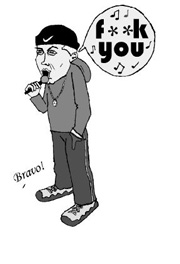(as told to its residents after the fact)
Light rail is coming. And in the smoke-free, paradigm-filled backrooms of Seattle’s process-loving movers and planners, important decisions about the futures of neighborhoods with light rail stations are being made—with public process as an afterthought, virtually incapable of derailing decisions that have already been made.
For two of Rainier Valley’s light rail stations on the Martin Luther King Jr. Way corridor in particular—those at Othello and Edmunds—radical changes are being proposed in zoning and neighborhood density. Planners say the changes have been in the works for over a year. But neighborhood activist Angela Ford of Save Our Valley says the changes have only appeared in the last month as a fait accompli. Ford says the neighborhood has been blindsided: “It’s an unholy alliance between DCLU, the Seattle Housing Authority, Sound Transit, the mayor’s office, and City Council.”
A total of eight of the light rail station planning areas, including all four in Rainier Valley, are slated for zoning changes: NE 45th Street, Capitol Hill, First Hill, Beacon Hill, McClellan, Edmunds, Othello, and Henderson. But the Edmunds and Othello stations are unique in that they are located next to two of the three largest public housing projects in Seattle: Holly Park and Rainier Vista. Both projects are in the midst of major Seattle Housing Authority remodeling efforts. They are included in Sound Transit’s quarter-mile radius overlays, within which some 2,000 new housing units are projected to be added over the next 20 years.
Little attention has been given so far to the radical nature of the changes SHA is planning. Zoning at the Edmunds station, adjacent to Rainier Vista, would change from L2 to L4—allowing for an increase from 480 to 1,600 units, with a totally out-of-character 65-foot tall, six-story monstrosity at the corner of MLK and South Alaska Street where single-family housing now sits.
Also not receiving much attention has been the proposed change in the nature of the housing. SHA, in its redevelopments at Holly Park and Rainier Vista, is removing some low income housing and attempting to generate more of a mixed income neighborhood.
That’s fine for civic planning, but begs the question of where Seattle’s increasingly desperate poor people are supposed to live. The SHA proposals also project that the new six-story buildings would be mixed use—opening up the prospect of SHA as a commercial landlord, putting it in competition with the marginal business district a half mile away on S Rainier Avenue and moving SHA ever farther from its original mission of providing housing for the poor.
City planner Carla Main, in touting the changes, says, “The direction we’ve gotten from the mayor and City Council is to push the envelope.”
Housing activist John Fox is, as usual, more blunt: “They’re using [light rail] as a cover for a massive gentrification scheme.”
The next step in making all this possible is the City Council’s Resolution 30165, to be voted on June 26. The resolution doesn’t contain the zoning changes themselves (those are slated to be enacted this summer) but concerns the “foundational vision” upon which later ordinances will be based. (Planners love this sort of language.)
At a May 22 City Council public hearing held at the Rainier Valley Cultural Center, almost none of the neighborhood’s poorest residents or SHA tenants offered testimony; those speaking were mostly small business owners, single-family homeowners, and other community activists. The comments were still overwhelmingly negative. Speakers wanted to know why their neighborhood was being made to bear the brunt of densification; why poor people were being driven out; why the process was being pushed through so quickly; and how small businesses were supposed to survive the massive changes.
While council member Richard Conlin, chairing the proceedings, said that a goal of the plans was to avoid gentrification, he also noted that Rainier Valley was selected for light rail in the first place because of its “commercial development possibilities.” Taken as a whole, the city, Sound Transit, and SHA plans seem like a blueprint for gentrification.
Written into the plans is an effort to diversify the income mix of residents (read: run off poor folks). The only businesses that will have the cash available to survive the projected three years of displacement (!) are the big out-of-town chains attracted by that diversified income. That’s gentrification.
And so, inexorably, the MLK corridor of Rainier Valley, led by the city’s public agency allegedly dedicated to providing housing for the poor, may become just as hostile toward poor and working-class families as, say, Queen Anne or View Ridge. Sadly, the city seems quite intent on that vision.
A bad reputation
Much ado was made in the local sports pages recently about the “exaggerated” nature of baseball superstar Rickey Henderson’s “bad reputation” after his acquisition last month by the Seattle Mariners. He’s really a misunderstood, but good, guy, you see. And wow, can he play.
Yet those endless reports on Henderson’s problems centered almost exclusively around things like team chemistry and willingness to hustle. None of the reports mentioned another, more ominous story: Henderson’s alleged attacks on women. In July 1991, a woman filed a complaint against him for assault after an argument in a hotel room. And in August 1994, Henderson was sued by his stepsister, who claimed that he raped her repeatedly as a youth, from the time she was 8 years old into her teens. (He denied the charges.)
Why is it that allegations of bad team chemistry are important, but allegations of assaulting women don’t receive the same coverage in our local sports media?







